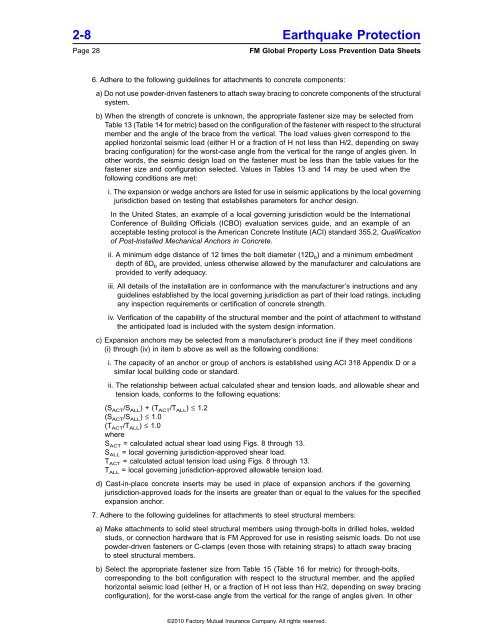DS 2-8 Earthquake Protection for Water-Based Fire ... - FM Global
DS 2-8 Earthquake Protection for Water-Based Fire ... - FM Global
DS 2-8 Earthquake Protection for Water-Based Fire ... - FM Global
Create successful ePaper yourself
Turn your PDF publications into a flip-book with our unique Google optimized e-Paper software.
2-8 <strong>Earthquake</strong> <strong>Protection</strong><br />
Page 28 <strong>FM</strong> <strong>Global</strong> Property Loss Prevention Data Sheets<br />
6. Adhere to the following guidelines <strong>for</strong> attachments to concrete components:<br />
a) Do not use powder-driven fasteners to attach sway bracing to concrete components of the structural<br />
system.<br />
b) When the strength of concrete is unknown, the appropriate fastener size may be selected from<br />
Table 13 (Table 14 <strong>for</strong> metric) based on the configuration of the fastener with respect to the structural<br />
member and the angle of the brace from the vertical. The load values given correspond to the<br />
applied horizontal seismic load (either H or a fraction of H not less than H/2, depending on sway<br />
bracing configuration) <strong>for</strong> the worst-case angle from the vertical <strong>for</strong> the range of angles given. In<br />
other words, the seismic design load on the fastener must be less than the table values <strong>for</strong> the<br />
fastener size and configuration selected. Values in Tables 13 and 14 may be used when the<br />
following conditions are met:<br />
i. The expansion or wedge anchors are listed <strong>for</strong> use in seismic applications by the local governing<br />
jurisdiction based on testing that establishes parameters <strong>for</strong> anchor design.<br />
In the United States, an example of a local governing jurisdiction would be the International<br />
Conference of Building Officials (ICBO) evaluation services guide, and an example of an<br />
acceptable testing protocol is the American Concrete Institute (ACI) standard 355.2, Qualification<br />
of Post-Installed Mechanical Anchors in Concrete.<br />
ii. A minimum edge distance of 12 times the bolt diameter (12D b) and a minimum embedment<br />
depth of 6D b are provided, unless otherwise allowed by the manufacturer and calculations are<br />
provided to verify adequacy.<br />
iii. All details of the installation are in con<strong>for</strong>mance with the manufacturer’s instructions and any<br />
guidelines established by the local governing jurisdiction as part of their load ratings, including<br />
any inspection requirements or certification of concrete strength.<br />
iv. Verification of the capability of the structural member and the point of attachment to withstand<br />
the anticipated load is included with the system design in<strong>for</strong>mation.<br />
c) Expansion anchors may be selected from a manufacturer’s product line if they meet conditions<br />
(i) through (iv) in item b above as well as the following conditions:<br />
i. The capacity of an anchor or group of anchors is established using ACI 318 Appendix D or a<br />
similar local building code or standard.<br />
ii. The relationship between actual calculated shear and tension loads, and allowable shear and<br />
tension loads, con<strong>for</strong>ms to the following equations:<br />
(S ACT/S ALL) +(T ACT/T ALL) ≤ 1.2<br />
(S ACT/S ALL) ≤ 1.0<br />
(T ACT/T ALL) ≤ 1.0<br />
where<br />
S ACT = calculated actual shear load using Figs. 8 through 13.<br />
S ALL = local governing jurisdiction-approved shear load.<br />
T ACT = calculated actual tension load using Figs. 8 through 13.<br />
T ALL = local governing jurisdiction-approved allowable tension load.<br />
d) Cast-in-place concrete inserts may be used in place of expansion anchors if the governing<br />
jurisdiction-approved loads <strong>for</strong> the inserts are greater than or equal to the values <strong>for</strong> the specified<br />
expansion anchor.<br />
7. Adhere to the following guidelines <strong>for</strong> attachments to steel structural members:<br />
a) Make attachments to solid steel structural members using through-bolts in drilled holes, welded<br />
studs, or connection hardware that is <strong>FM</strong> Approved <strong>for</strong> use in resisting seismic loads. Do not use<br />
powder-driven fasteners or C-clamps (even those with retaining straps) to attach sway bracing<br />
to steel structural members.<br />
b) Select the appropriate fastener size from Table 15 (Table 16 <strong>for</strong> metric) <strong>for</strong> through-bolts,<br />
corresponding to the bolt configuration with respect to the structural member, and the applied<br />
horizontal seismic load (either H, or a fraction of H not less than H/2, depending on sway bracing<br />
configuration), <strong>for</strong> the worst-case angle from the vertical <strong>for</strong> the range of angles given. In other<br />
©2010 Factory Mutual Insurance Company. All rights reserved.

















